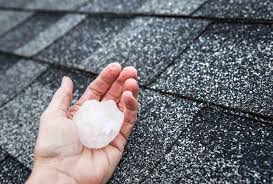The Hail Damage Repair Process: What Homeowners Should Expect
Hailstorms can strike unexpectedly, leaving behind a trail of damage to homes, vehicles, and other property. For homeowners, one of the most pressing concerns after a storm is assessing and repairing the damage to their roofs, siding, and other exterior surfaces. Understanding the hail damage repair process can help ease concerns and ensure a smooth recovery. Get fast and reliable hail damage repair to restore your roof after a storm.

Assessing the Damage
After a hailstorm, homeowners should conduct a thorough visual inspection of their property. While some damage, such as broken windows or dented siding, is immediately noticeable, roof damage may not always be as apparent. Hail can create dents, cracks, or loosen shingles, potentially leading to leaks if left unaddressed. Checking for granule loss on shingles, dents on metal surfaces, and damage to gutters or downspouts can help determine the severity of the situation.
Contacting an Insurance Provider
Once damage is identified, homeowners should notify their insurance company as soon as possible. Most homeowner’s insurance policies cover hail damage, but the extent of coverage depends on individual policy terms. An insurance adjuster will typically be sent to assess the property, document the damage, and provide an estimate for repairs. It is helpful to have personal documentation, including photos and videos of the damage, to support the claim. Keeping records of any communication with the insurance company ensures a transparent process.
Hiring a Professional Contractor
Selecting a reputable contractor is one of the most crucial steps in the repair process. Homeowners should look for licensed and insured professionals with experience in hail damage repairs. Obtaining multiple quotes can provide a better understanding of the costs involved and prevent overcharges. Additionally, it is beneficial to choose a contractor familiar with insurance claims to help streamline the process.
Storm-chasing contractors may appear in affected neighborhoods offering quick repairs, but homeowners should be cautious and verify credentials before hiring anyone. Checking online reviews, asking for references, and confirming proper licensing can prevent potential scams or subpar workmanship.
The Repair Process Begins
Once the insurance claim is approved and a contractor is selected, the actual repair work can begin. The process varies depending on the extent of the damage.
For roofs, the contractor may replace damaged shingles, reinforce structural components, and check for underlying issues such as water damage. If the hailstorm caused extensive damage, a full roof replacement may be necessary. In cases where siding or windows were affected, the contractor will repair or replace the damaged sections to restore the home’s exterior integrity.
During this stage, homeowners should expect some noise and temporary disruptions. Contractors typically work within an agreed-upon timeframe, but factors like weather conditions and material availability can influence the schedule. Clear communication with the contractor helps ensure the process stays on track.
Post-Repair Inspection and Final Steps
After repairs are completed, a final inspection is conducted to confirm that all damage has been addressed. Homeowners should take the time to walk through the repaired areas with the contractor to verify the quality of the work. Any concerns should be brought up before making the final payment.
Some contractors offer warranties on their work, providing homeowners with additional peace of mind. Reviewing warranty terms and keeping all repair-related documents organized can be beneficial in case future issues arise.
Preventative Measures for the Future
While hailstorms cannot be prevented, there are steps homeowners can take to minimize potential damage. Installing impact-resistant roofing materials can provide better protection against future storms. Regular maintenance, including cleaning gutters and checking for loose shingles, helps keep the home in good condition. If living in an area prone to hailstorms, investing in protective coverings for windows and outdoor structures can help reduce the risk of severe damage.